Fortunately for such, our ancestors in the palmy days of glass manufacture freely availed themselves of the possibilities of this form of advertisement and commemoration, so that a considerable number of memorial pieces are still in existence. Many of these were, of course, merely intended to record some happening of purely6 local significance: the building of a bridge, the opening of a canal, the launching of a ship; or, narrowing the interest still further, the birth of a son or the marriage of a daughter. Others, however, had a wider appeal: a great national victory on sea or land, the winning of{96} an election, or the passage or defeat of a hotly contested Bill in Parliament. All were suitably inscribed7 and generally dated—a fact which adds to their importance and value—and frequently decorated, in addition to the usual conventional designs, with a more or less crude pictorial8 representation of the event or of some important factor connected with it. Thus the battle of Trafalgar would be indicated by a picture of the famous victory or by a portrait of Nelson. Frequently such glasses were dedicated9 to the glorification10 of some famous hero, as were the Nelson glasses, Keppel glasses, etc.; or to the furtherance of some great cause, as the Jacobite glasses, with which we shall have presently to deal at length; or, again, to the diffusion11 of some political principle.
The collector must, however, be chary12 of assuming that a memorial glass was necessarily contemporary with the event it records. The warning is particularly necessary in the case of Jacobite glasses, of which large numbers were made by faithful adherents13 of the House of Stuart long after the Jacobite cause had been relegated14 to the limbo15 of lost hopes. And it is perhaps unnecessary to add the further warning
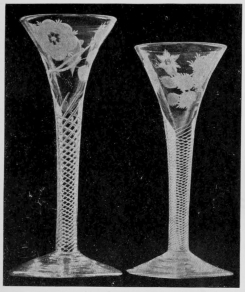
that in connection with old glass, as with other antiques, the supply seems somehow mysteriously to adapt itself to the demand; and it is the easiest and least detectable16 of frauds to take a veritable old glass of no particular merit, and by inscribing17 it with a motto and an emblem18 or two, increase its value twenty-fold.
There is, of course, much old glass stored, more or less inaccessibly19, in ancient houses up and down the country, and every now and again some such hidden treasure is brought to light. But it may be generally said that, in view of the fierce light the modern craze for antiques has thrown upon such hiding-places, the prospects21 of the present-day collector of finding, say, a “Fiat” glass are so remote as to be practically negligible.
The Jacobite glasses form by far the most important of English memorial glasses. They were used by the followers22 of the ill-fated House of Stuart, not only in their homes—where, indeed, their use might be dangerous—but in the clubs and secret societies which met to keep alive the Pretender’s memory, and to plot for his return. Great numbers were probably made, mostly, it is thought, at Newcastle, whence the{98} manufacturers might, in case of need, speedily retire across the Border and seek concealment23 from the law among a sympathetic population. Unfortunately, few only remain, for when the toast had been duly honoured, it was a frequent custom to shatter the glass, that it might be used for no inferior purpose. A similar custom prevails still in certain military messes, the stem of the wine glass being snapped after the toast of the reigning25 monarch26 has been duly drunk.
Some of the Jacobite glasses, however, were of superior quality and admirably inscribed and decorated. These, it is assumed, were carried from place to place by their owners, often in properly fitted cabinets. Each member of a Jacobite club probably brought his own glass, which was stored, with the others, between the meetings, in a secret receptacle; the possession of such a glass being, of course, treason. Thus it is that many have been preserved—frail memories of a lost cause and symbols of a loyalty27 as unparalleled as incomprehensible. At this distance of time it is difficult to understand the glamour28 that surrounded the Stuart cause and the wealth of loyalty that was lavished29 on objects so painfully unworthy.{99}
James I. was a foreigner to England and English sentiment, and with none of the qualities that win admiration31 or esteem32. He was ungainly, garrulous33, vain, pedantic34, and, above all, cowardly in an age which placed physical courage as the first of human attributes. Even his not inconsiderable intellect failed to compensate35 for an utter lack of everything else which his time found worthy30 of admiration. Charles I. was a tyrant36, narrow, mean, obstinate37, and unscrupulous—a man without ability, a king without honour. His death is the one bright spot in a dreary38 and disastrous39 record, for
“Nothing in his life
Became him like the leaving of it.”
Charles II., gay, witty40, insouciant41, reckless, had, it may be granted, certain qualities that take the common taste, but he was utterly42 profligate43, entirely44 without principle. He sold England to France, betrayed Holland, robbed the State and the Navy, and starved his sailors to flatter his mistresses. James II. was cold, callous45, cruel—a sycophant46 to the strong and a tyrant to the weak. He was a bigot, and unscrupulous in his bigotry47. He was no less{100} licentious48 than his brother though much more a hypocrite.
What was the glamour that made men give their all—house, wealth, lands, and even life itself—to bolster49 the falling fortunes of an unworthy line and restore it to the throne from which it had been twice driven by an outraged50 people? But we are digressing. There is, in any case, no doubt as to the glamour which surrounds the Jacobite glasses in the eyes of the collector of to-day.
The greater part of these glasses were used in one or other of the various clubs or societies which sprang up for the purpose of propagating Jacobite principles and furthering the Jacobite cause—which meant, in brief, plotting for the downfall of the House of Hanover, and in a hard-drinking age it was clear that their consultations51 could not have been carried on without a considerable consumption of strong liquors, and a consequent adequate supply of glasses, the majority of which were probably engraved53 in some way or another distinctive54 of the occasion.
The most famous of such clubs was the Cycle Club, founded in 1710 by Sir Watkin Wynn,
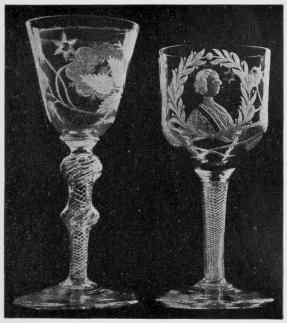
and one of the most interesting of commemorative glasses refers to him:
“Let no deceipt within your glass be found,
But glorious Watkin’s health go briskly round.”
The motto of the Cycle Club appears to have been the Latin “Fiat” (“May it happen”), and this word is generally found engraved on Jacobite glasses, which are, in consequence, often referred to as “Fiat” glasses. A “Fiat” glass is shown in Fig55. 21, and other excellent specimens of Jacobite glasses in Fig. 19. Another motto is “Redeat.”
The best of the Jacobite glasses bear the portrait of “Bonnie Prince Charlie” on the bowl, encircled by a wreath of laurel, flanked on each side by Scotland’s emblematic56 thistle. Others have two roses supporting the laurels57. Sometimes there is the Stuart rose, with two buds, a reference, perhaps, to James II. and his two sons. The design, too, not unfrequently includes an oak leaf, a reference to Charles II.’s escape from the Roundheads, after the battle of Worcester, by taking refuge in an oak, while
“Far below the Roundhead rode
And humm’d a surly hymn58.”
Some also are engraved, in addition, with a star—the symbol{102} of a hope never realised by the hapless Stuart line. Most of these emblems59 may be found in the two specimens shown in Fig. 19.
I have sometimes found the portrait of the Pretender with oak leaves, thistle, and rose, in place of the usual “Fiat,” and the motto “Audentior Ibo.”
These glasses have usually air-drawn or knopped stems and funnel-shaped bowls. These Jacobite glasses are among the luckiest “finds” of the collector of Old English glass, and it is needless to say that the greatest care is essential in purchasing anything which purports60 to be a genuine specimen1. “Fiat” glasses, especially those bearing the portrait of the Pretender, are imitated in considerable numbers and generally disposed of through the shops of small country dealers62, pawnbrokers63, etc.; but I have seen specimens, even in galleries and large shops in London, which were flagrant frauds, a fact which should have been perfectly64 patent to the vendors65. So caveat66 emptor.
Frequently the ordinary tests for the antiquity67 of the glass are useless, since the piece is itself genuine old glass of the proper period and
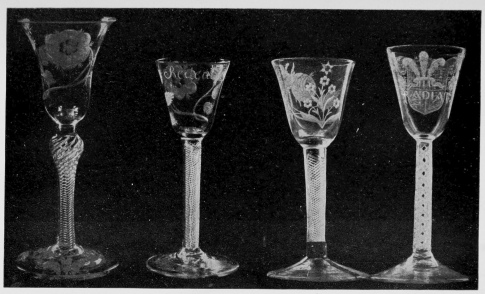
FIG. 19—JACOBITE GLASSES.
(From the Rees Collection, by permission of the Connoisseur68.)
only the engraving69 modern, and this is given a spurious appearance of age by rubbing down with sand and earth, and by allowing the lines of the pattern to become filled with dust and dirt. A test that may be found useful is to hold the piece in a strong light, when some part of the engraved portion may be found untouched by the “treatment,” and bearing in its clearness and sharpness of line convincing evidence of its recent origin.
Of the Jacobite glasses, those dedicated to the Old Pretender are entirely beyond the hopes of the ordinary collector. A few exist in old country houses dotted up and down the country and in various museums. One in the British Museum bears the mottoes “Cognoscunt me mei” and “Premium Virtutis.” Young Pretender glasses are naturally much more numerous, and it is probable that specimens may still be found in out-of-the-way places.
Special finds of Jacobite glasses are occasionally made, a whole set being discovered in some unexpected hiding-place. One such set is the famous Oxburgh Hall find, now to be seen and admired in the Victoria and Albert Museum. Eleven Jacobite glasses in all were discovered,{104} eight of them being “Fiat” glasses. Four of them, of a larger size, bear the Prince of Wales’ feathers on the upper surface of the foot. One is the glass inscribed to Sir Watkin Wynn, previously70 mentioned, and one is of special significance, in that it bears in addition to a portrait of the Young Pretender an inscription71, unique in the history of Jacobite glass:
“Charles ye Great, ye Brave, the Just and Good
Britania’s Prince ye noblest of her Bld.
Thy Glorious Feats72 ye World may Pro20?
Britania’s Glory and Britaine Shame.”
As poetry the verse undoubtedly73 leaves something to be desired, although as a panegyric74 it is fairly comprehensive. That fact will, however, in nowise detract from its unique interest in the eyes of the collector, whilst the most rabid Jacobite—if such a person still exists—can hardly fail to be satisfied with such a wholesale75 and whole-hearted testimony76 to the merits of the leader whose cause he had espoused—the luckless Prince, whose doom77 it was to be always remembered “Over the water,” “Great, Brave, Just, Good, Britania’s glory,” and the rest! This was a hero indeed, sans peur et sans reproche. Even the legendary{105} Arthur of Round Table fame could hardly claim more.
A critic might suggest that the portrait which appears on the other side of the glass is hardly worthy of these exalted78 sentiments, though in point of artistic79 merit it may fitly challenge comparison with the quality of the verse.
The “Chastleton” glasses form another famous Jacobite set. There are two decanters and eleven wine glasses. The glasses are engraved with the rose and two buds, representing, presumably, James II. and the two Pretenders, and the Cycle Club motto, “Fiat.” In addition there is an oak leaf. Whether this is an allusion80 to the famous Royal Oak of Boscobel, in which Charles II. took refuge after Worcester, as previously mentioned, or is merely the distinguishing mark of the English Jacobites, just as the thistle was the badge of their Scottish comrades, is obscure.
The decanters are still more interesting, having, in addition to the rose and its two buds, two oak leaves and a compass, the needle of which points to a star apparently81 rising towards the zenith—probably in hopeful anticipation82 of the fortunes of the Jacobite cause. Miss{106} Whitmore Jones, the present owner of Chastleton, claims that these were made at Derby.
Glasses thus elaborately inscribed do not exhaust the list of Jacobite glasses. In many cases the rose emblem appears alone, without the incriminating “Fiat” which would inevitably83 convict the owner of treason. In other cases the emblem was hidden from the casual eye by being engraved underneath84 the foot. The times were perilous85 ones, and it behoved careful folk to exercise the greatest caution; hence arose all the system of symbols and catchwords associated with the Jacobite cause. Byrom sums up their attitude in the well-known verse:
“God bless the King, I mean the faith’s defender86;
God bless—no harm in blessing—the Pretender;
But who pretender is, or who is king,—
God bless us all,—that’s quite another thing.”
It is possible to meet, here and there, with glasses dedicated to the early Georges, but these are few and, to say the truth, are lacking in the interest that their romantic and tragic87 history threw over everything associated with the hapless Stuart line.
Williamite glasses are more numerous. They,{107}
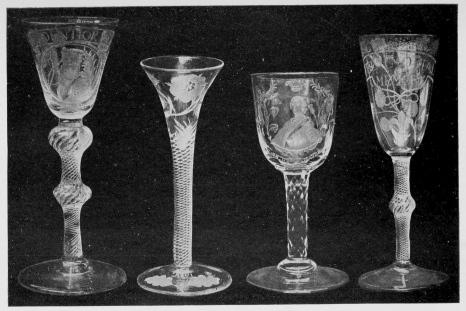
of course, date from the revolution of 1688, when party feeling on the one side ran as high in favour of Dutch William as it did on the other in favour of the House of Stuart. Many of them were undoubtedly produced in Ireland, the more interesting commemorating88 the battle of the Boyne. Some bear the portrait of the King—generally crossing the Boyne on horseback. Such specimens are exceedingly rare. Later ones bear only an inscription, “To the Immortal89 Memory,” or “To the Immortal Memory of the glorious King William,” with possibly a rosebud90. These are, of course, more ordinary, but are still worth collecting, providing the purchaser can assure himself that they have not been specially61 prepared for his benefit.
The phrase above quoted is possibly a reminiscence of the toast given at Orange meetings: “To the glorious, pious91, and immortal memory of the great and good King William, who freed us from Pope and popery, knavery92 and slavery, brass93 money and wooden shoes”—quite a creditable record of achievements.
The “boot” glasses, to which we refer among the freaks, were probably made in large numbers in George III.’s reign24 to testify to the{108} national hatred94 of Lord Bute, whose punning emblem, “the boot,” was burnt by the mob in a thousand bonfires, whether justly or unjustly history fails to say. But there is no doubt that Bute was hated with a fury almost without precedent95, and the King’s mother, whose favourite he was, was hated with equal intensity96. In 1763 a jack-boot and a petticoat were publicly burnt at Temple Bar, and a crowned ass3 led through the streets by a man in a Scottish plaid. Boot glasses are generally from four and a half to five inches in height. They are often moulded to represent lacings in the front and trimmings at the sides, and were doubtless used for strong waters, cordials, and liqueurs.
Memorial glasses inscribed with the names of our great seamen97 are, of course, numerous. One to Admiral Hawke, inscribed “Success to the British Fleet” and dated 20th November 1759, was evidently made in commemoration of the battle of Quiberon Bay, in which that great seaman98, deliberately99 ignoring the fighting instructions, flung convention to the winds and won a startling victory, and freed Britain from the dread100 of a French invasion. Similar glasses{109}
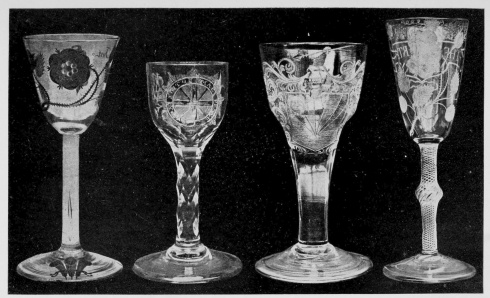
A “FIAT” GLASS SHEWING STUART ROSE WITH SIX PETALS101.
union GLASS, CIRCA. 1801.
ARMORIAL GLASS.
WILLIAMITE GLASS.
FIG. 21.
FIG. 20.—MEMORIAL TOASTING GLASSES—JACOBITE AND WILLIAMITE.
bear the names of Boscawen, Rodney, Anson, Keppel, and Nelson.
The “Nelson” glasses, as may be supposed, are particularly interesting. Some bear the hero’s portrait; others are adorned102 with a representation of his famous flagship; others, again, were made in commemoration of his death and his burial in St Paul’s Cathedral.
One such specimen described by Mr Hartshorne deserves special mention. It is a goblet103 rather more than 8 inches in height, on the straight-sided bowl being engraved a representation of the great Admiral’s funeral car in the shape of a ship. On the stern is the historic name Victory. At the prow104 stands an emblematic figure of Victory, bearing in one hand a laurel wreath and in the other a branch of bay. On the canopy105 of the car is inscribed the word “Trafalgar,” below it the name “Nile.” It is stated that the glasses were made for the officers of the Victory, each of whom received one in memory of his chief.
The ordinary commemoration glasses made at the time of Nelson’s funeral, and publicly sold as memorials of the event, have on the one side a representation of the funeral car and{110} on the other, encircled by a laurel wreath, the words:
In Memory
of Lord
Nelson
Jan? 9?? 1806
The date is that of the public funeral. These glasses were probably made in considerable numbers, but are now very rare.
Apart, however, from the funeral glasses great numbers of pieces must have been inscribed with his name as a testimony to his popularity and of the public gratitude106 for his victories.
Miss Wilmer in her book on “Early English Glass” gives an illustration of a tumbler inscribed with the names of Nelson, Duncan, Howe, and St Vincent and the date 1st August 1798, together with various nautical107 emblems. But, as we have said, the manufacture of commemorative glasses was not confined to occasions of national importance, nor were such glasses dedicated only to national heroes.
Events of very local importance were frequently signalised in this way. Thus one is inscribed “Up to Sowerby Bridge, 1758,” and serves to record certain improvements in the{111}
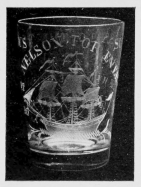
A NELSON GLASS
FIG 22.
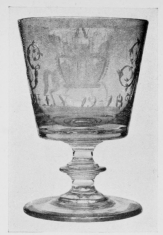
A COMMEMORATIVE CORONATION GLASS OF KING GEORGE IV.
navigation of the Calder River. A golden fleece which also forms part of the decoration symbolises possibly the commercial advantages likely to accrue108 thereby109. Another commemorates110 the opening of the Aire to Calder Canal, and bears the inscription, “Success to Trade and Navigation.” Others bear political cries, like a cider glass (Fig. 23) from the Singer Collection. It is characteristically engraved with sprigs of apple blossom and a barrel, presumably of cider. Around the brim is the legend, “No Excise,” a probable reference to the political agitation112 which followed the attempt of the Chancellor113 of the Exchequer114, Sir Francis Dashwood, in 1763 to impose a duty of no less than 4s. a hogshead on cider.
The next glass is from the same collection. It bears a ship engraved upon the bowl, and has a thickly twisted opal stem and slightly waisted sides, which give a peculiar115 charm to its shape. On it are inscribed the words, “Success to the Eagle Frigate—John Knill, Commander,” which seems to indicate that it was made to commemorate111 the launch of that vessel116. The fine air-twisted goblet, which is the largest in the illustration, belongs to a period{112} somewhere about 1760. The figure depicted117 is that of Frederick the Great, King of Prussia, then our ally and at the zenith of his military glory. It was through his aid that Pitt was enabled to win our colonies of India and America on the battlefields of Europe, and the exhortation118 to “Keep it up,” which appears on the glass, was evidently the expression of some British sympathiser’s goodwill119. Possibly the piece was made to celebrate one of Frederick’s victories.
The other glass has a small portrait with the inscription, “Long live George, Prince of Wales, 1759.” It is beautifully engraved and altogether one of the finest specimens extant.
Fig. 27 illustrates120 particularly fine and interesting examples of a tankard, a covered jar, and a grog glass—all excellent of their kind. The tankard on the right of the plate is engraved with vine leaves and bunches of grapes, together with marguerites, and inscribed with the names Joseph and Jane Burrows121, and was probably a “marriage” or “betrothal” glass.
The goblet with a square base which stands to the left of the plate (Fig. 24) is very quaint122. There is a representation of a sailing craft upon
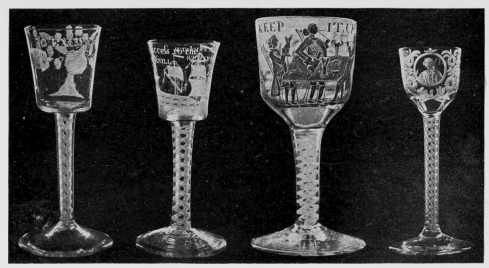
FIG. 23.—COMMEMORATIVE GLASSES.
(From the Rees Price Collection, by permission of the Connoisseurs123.)
one side, with the inscription, “The Ann and Bessie,” and on the reverse, “James Oddie, Bromley,” probably the name of the owner both of the craft and the goblet, who registered to posterity124 his pride in the one by means of the other. This glass, I am informed, was the property of the late A. P. Trapnel, Esq., a renowned125 collector of Bristol porcelain126 and, though to a less degree, of old glass.
The covered grog pot or jar in the centre of the group is artistically127 engraved with roses and festoons, with the inscription, “Success to the Britannia, Edmund Eccleston, 1774.”
For the illustrations of several of the above pieces I am indebted to the courtesy of the late Mr J. T. Herbert Bailey. Such examples, which cannot fail to interest the lover of art as well as the collector of antiques, amply testify to the strides which glass manufacture had made in England, and are also useful as indicating the nature of the finds a collector may even yet make in out-of-the-way places, provided he will first take the precaution to acquire such knowledge of the characteristics of old glass as will serve to protect him from being deceived by modern reproductions. One does not, for example,{114} expect to find engraving or cutting on early importations from Venice, or that the glasses made in commemoration of various events invariably bear appropriate inscriptions128, by which they may be immediately identified. Sometimes there is a date alone, sometimes a figure or merely initials, and the collector’s imagination and historical knowledge, as well as his expert acquaintance with the qualities of old glass, are all called into play to determine the date and occasion when the specimen was produced.
It need hardly be said that historical and commemorative glass are very widely imitated, the commonest and most plausible129 of the various forms of deception130 adopted being, as elsewhere suggested, to engrave52 some comparatively valueless specimen of real old glass with figures exactly imitating the genuine thing, and so giving it a fictitious131 value.{115}
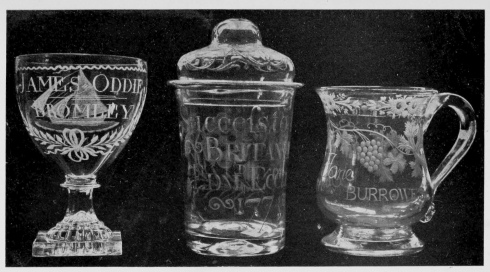
FIG. 24.—TANKARDS AND GROG GLASSES. EARLY 18th CENTURY.
(From the Rees Price Collection, by permission of the Connoisseur).

点击 收听单词发音
收听单词发音
 收听单词发音
收听单词发音
1
specimen

|
|
| n.样本,标本 | |
参考例句: |
|
|
|
2
specimens

|
|
| n.样品( specimen的名词复数 );范例;(化验的)抽样;某种类型的人 | |
参考例句: |
|
|
|
3
ass

|
|
| n.驴;傻瓜,蠢笨的人 | |
参考例句: |
|
|
|
4
fascination

|
|
| n.令人着迷的事物,魅力,迷恋 | |
参考例句: |
|
|
|
5
derive

|
|
| v.取得;导出;引申;来自;源自;出自 | |
参考例句: |
|
|
|
6
purely

|
|
| adv.纯粹地,完全地 | |
参考例句: |
|
|
|
7
inscribed

|
|
| v.写,刻( inscribe的过去式和过去分词 );内接 | |
参考例句: |
|
|
|
8
pictorial

|
|
| adj.绘画的;图片的;n.画报 | |
参考例句: |
|
|
|
9
dedicated

|
|
| adj.一心一意的;献身的;热诚的 | |
参考例句: |
|
|
|
10
glorification

|
|
| n.赞颂 | |
参考例句: |
|
|
|
11
diffusion

|
|
| n.流布;普及;散漫 | |
参考例句: |
|
|
|
12
chary

|
|
| adj.谨慎的,细心的 | |
参考例句: |
|
|
|
13
adherents

|
|
| n.支持者,拥护者( adherent的名词复数 );党羽;徒子徒孙 | |
参考例句: |
|
|
|
14
relegated

|
|
| v.使降级( relegate的过去式和过去分词 );使降职;转移;把…归类 | |
参考例句: |
|
|
|
15
limbo

|
|
| n.地狱的边缘;监狱 | |
参考例句: |
|
|
|
16
detectable

|
|
| adj.可发觉的;可查明的 | |
参考例句: |
|
|
|
17
inscribing

|
|
| v.写,刻( inscribe的现在分词 ) | |
参考例句: |
|
|
|
18
emblem

|
|
| n.象征,标志;徽章 | |
参考例句: |
|
|
|
19
inaccessibly

|
|
| Inaccessibly | |
参考例句: |
|
|
|
20
pro

|
|
| n.赞成,赞成的意见,赞成者 | |
参考例句: |
|
|
|
21
prospects

|
|
| n.希望,前途(恒为复数) | |
参考例句: |
|
|
|
22
followers

|
|
| 追随者( follower的名词复数 ); 用户; 契据的附面; 从动件 | |
参考例句: |
|
|
|
23
concealment

|
|
| n.隐藏, 掩盖,隐瞒 | |
参考例句: |
|
|
|
24
reign

|
|
| n.统治时期,统治,支配,盛行;v.占优势 | |
参考例句: |
|
|
|
25
reigning

|
|
| adj.统治的,起支配作用的 | |
参考例句: |
|
|
|
26
monarch

|
|
| n.帝王,君主,最高统治者 | |
参考例句: |
|
|
|
27
loyalty

|
|
| n.忠诚,忠心 | |
参考例句: |
|
|
|
28
glamour

|
|
| n.魔力,魅力;vt.迷住 | |
参考例句: |
|
|
|
29
lavished

|
|
| v.过分给予,滥施( lavish的过去式和过去分词 ) | |
参考例句: |
|
|
|
30
worthy

|
|
| adj.(of)值得的,配得上的;有价值的 | |
参考例句: |
|
|
|
31
admiration

|
|
| n.钦佩,赞美,羡慕 | |
参考例句: |
|
|
|
32
esteem

|
|
| n.尊敬,尊重;vt.尊重,敬重;把…看作 | |
参考例句: |
|
|
|
33
garrulous

|
|
| adj.唠叨的,多话的 | |
参考例句: |
|
|
|
34
pedantic

|
|
| adj.卖弄学问的;迂腐的 | |
参考例句: |
|
|
|
35
compensate

|
|
| vt.补偿,赔偿;酬报 vi.弥补;补偿;抵消 | |
参考例句: |
|
|
|
36
tyrant

|
|
| n.暴君,专制的君主,残暴的人 | |
参考例句: |
|
|
|
37
obstinate

|
|
| adj.顽固的,倔强的,不易屈服的,较难治愈的 | |
参考例句: |
|
|
|
38
dreary

|
|
| adj.令人沮丧的,沉闷的,单调乏味的 | |
参考例句: |
|
|
|
39
disastrous

|
|
| adj.灾难性的,造成灾害的;极坏的,很糟的 | |
参考例句: |
|
|
|
40
witty

|
|
| adj.机智的,风趣的 | |
参考例句: |
|
|
|
41
insouciant

|
|
| adj.不在意的 | |
参考例句: |
|
|
|
42
utterly

|
|
| adv.完全地,绝对地 | |
参考例句: |
|
|
|
43
profligate

|
|
| adj.行为不检的;n.放荡的人,浪子,肆意挥霍者 | |
参考例句: |
|
|
|
44
entirely

|
|
| ad.全部地,完整地;完全地,彻底地 | |
参考例句: |
|
|
|
45
callous

|
|
| adj.无情的,冷淡的,硬结的,起老茧的 | |
参考例句: |
|
|
|
46
sycophant

|
|
| n.马屁精 | |
参考例句: |
|
|
|
47
bigotry

|
|
| n.偏见,偏执,持偏见的行为[态度]等 | |
参考例句: |
|
|
|
48
licentious

|
|
| adj.放纵的,淫乱的 | |
参考例句: |
|
|
|
49
bolster

|
|
| n.枕垫;v.支持,鼓励 | |
参考例句: |
|
|
|
50
outraged

|
|
| a.震惊的,义愤填膺的 | |
参考例句: |
|
|
|
51
consultations

|
|
| n.磋商(会议)( consultation的名词复数 );商讨会;协商会;查找 | |
参考例句: |
|
|
|
52
engrave

|
|
| vt.(在...上)雕刻,使铭记,使牢记 | |
参考例句: |
|
|
|
53
engraved

|
|
| v.在(硬物)上雕刻(字,画等)( engrave的过去式和过去分词 );将某事物深深印在(记忆或头脑中) | |
参考例句: |
|
|
|
54
distinctive

|
|
| adj.特别的,有特色的,与众不同的 | |
参考例句: |
|
|
|
55
fig

|
|
| n.无花果(树) | |
参考例句: |
|
|
|
56
emblematic

|
|
| adj.象征的,可当标志的;象征性 | |
参考例句: |
|
|
|
57
laurels

|
|
| n.桂冠,荣誉 | |
参考例句: |
|
|
|
58
hymn

|
|
| n.赞美诗,圣歌,颂歌 | |
参考例句: |
|
|
|
59
emblems

|
|
| n.象征,标记( emblem的名词复数 ) | |
参考例句: |
|
|
|
60
purports

|
|
| v.声称是…,(装得)像是…的样子( purport的第三人称单数 ) | |
参考例句: |
|
|
|
61
specially

|
|
| adv.特定地;特殊地;明确地 | |
参考例句: |
|
|
|
62
dealers

|
|
| n.商人( dealer的名词复数 );贩毒者;毒品贩子;发牌者 | |
参考例句: |
|
|
|
63
pawnbrokers

|
|
| n.当铺老板( pawnbroker的名词复数 ) | |
参考例句: |
|
|
|
64
perfectly

|
|
| adv.完美地,无可非议地,彻底地 | |
参考例句: |
|
|
|
65
vendors

|
|
| n.摊贩( vendor的名词复数 );小贩;(房屋等的)卖主;卖方 | |
参考例句: |
|
|
|
66
caveat

|
|
| n.警告; 防止误解的说明 | |
参考例句: |
|
|
|
67
antiquity

|
|
| n.古老;高龄;古物,古迹 | |
参考例句: |
|
|
|
68
connoisseur

|
|
| n.鉴赏家,行家,内行 | |
参考例句: |
|
|
|
69
engraving

|
|
| n.版画;雕刻(作品);雕刻艺术;镌版术v.在(硬物)上雕刻(字,画等)( engrave的现在分词 );将某事物深深印在(记忆或头脑中) | |
参考例句: |
|
|
|
70
previously

|
|
| adv.以前,先前(地) | |
参考例句: |
|
|
|
71
inscription

|
|
| n.(尤指石块上的)刻印文字,铭文,碑文 | |
参考例句: |
|
|
|
72
feats

|
|
| 功绩,伟业,技艺( feat的名词复数 ) | |
参考例句: |
|
|
|
73
undoubtedly

|
|
| adv.确实地,无疑地 | |
参考例句: |
|
|
|
74
panegyric

|
|
| n.颂词,颂扬 | |
参考例句: |
|
|
|
75
wholesale

|
|
| n.批发;adv.以批发方式;vt.批发,成批出售 | |
参考例句: |
|
|
|
76
testimony

|
|
| n.证词;见证,证明 | |
参考例句: |
|
|
|
77
doom

|
|
| n.厄运,劫数;v.注定,命定 | |
参考例句: |
|
|
|
78
exalted

|
|
| adj.(地位等)高的,崇高的;尊贵的,高尚的 | |
参考例句: |
|
|
|
79
artistic

|
|
| adj.艺术(家)的,美术(家)的;善于艺术创作的 | |
参考例句: |
|
|
|
80
allusion

|
|
| n.暗示,间接提示 | |
参考例句: |
|
|
|
81
apparently

|
|
| adv.显然地;表面上,似乎 | |
参考例句: |
|
|
|
82
anticipation

|
|
| n.预期,预料,期望 | |
参考例句: |
|
|
|
83
inevitably

|
|
| adv.不可避免地;必然发生地 | |
参考例句: |
|
|
|
84
underneath

|
|
| adj.在...下面,在...底下;adv.在下面 | |
参考例句: |
|
|
|
85
perilous

|
|
| adj.危险的,冒险的 | |
参考例句: |
|
|
|
86
defender

|
|
| n.保卫者,拥护者,辩护人 | |
参考例句: |
|
|
|
87
tragic

|
|
| adj.悲剧的,悲剧性的,悲惨的 | |
参考例句: |
|
|
|
88
commemorating

|
|
| v.纪念,庆祝( commemorate的现在分词 ) | |
参考例句: |
|
|
|
89
immortal

|
|
| adj.不朽的;永生的,不死的;神的 | |
参考例句: |
|
|
|
90
rosebud

|
|
| n.蔷薇花蕾,妙龄少女 | |
参考例句: |
|
|
|
91
pious

|
|
| adj.虔诚的;道貌岸然的 | |
参考例句: |
|
|
|
92
knavery

|
|
| n.恶行,欺诈的行为 | |
参考例句: |
|
|
|
93
brass

|
|
| n.黄铜;黄铜器,铜管乐器 | |
参考例句: |
|
|
|
94
hatred

|
|
| n.憎恶,憎恨,仇恨 | |
参考例句: |
|
|
|
95
precedent

|
|
| n.先例,前例;惯例;adj.在前的,在先的 | |
参考例句: |
|
|
|
96
intensity

|
|
| n.强烈,剧烈;强度;烈度 | |
参考例句: |
|
|
|
97
seamen

|
|
| n.海员 | |
参考例句: |
|
|
|
98
seaman

|
|
| n.海员,水手,水兵 | |
参考例句: |
|
|
|
99
deliberately

|
|
| adv.审慎地;蓄意地;故意地 | |
参考例句: |
|
|
|
100
dread

|
|
| vt.担忧,忧虑;惧怕,不敢;n.担忧,畏惧 | |
参考例句: |
|
|
|
101
petals

|
|
| n.花瓣( petal的名词复数 ) | |
参考例句: |
|
|
|
102
adorned

|
|
| [计]被修饰的 | |
参考例句: |
|
|
|
103
goblet

|
|
| n.高脚酒杯 | |
参考例句: |
|
|
|
104
prow

|
|
| n.(飞机)机头,船头 | |
参考例句: |
|
|
|
105
canopy

|
|
| n.天篷,遮篷 | |
参考例句: |
|
|
|
106
gratitude

|
|
| adj.感激,感谢 | |
参考例句: |
|
|
|
107
nautical

|
|
| adj.海上的,航海的,船员的 | |
参考例句: |
|
|
|
108
accrue

|
|
| v.(利息等)增大,增多 | |
参考例句: |
|
|
|
109
thereby

|
|
| adv.因此,从而 | |
参考例句: |
|
|
|
110
commemorates

|
|
| n.纪念,庆祝( commemorate的名词复数 )v.纪念,庆祝( commemorate的第三人称单数 ) | |
参考例句: |
|
|
|
111
commemorate

|
|
| vt.纪念,庆祝 | |
参考例句: |
|
|
|
112
agitation

|
|
| n.搅动;搅拌;鼓动,煽动 | |
参考例句: |
|
|
|
113
chancellor

|
|
| n.(英)大臣;法官;(德、奥)总理;大学校长 | |
参考例句: |
|
|
|
114
exchequer

|
|
| n.财政部;国库 | |
参考例句: |
|
|
|
115
peculiar

|
|
| adj.古怪的,异常的;特殊的,特有的 | |
参考例句: |
|
|
|
116
vessel

|
|
| n.船舶;容器,器皿;管,导管,血管 | |
参考例句: |
|
|
|
117
depicted

|
|
| 描绘,描画( depict的过去式和过去分词 ); 描述 | |
参考例句: |
|
|
|
118
exhortation

|
|
| n.劝告,规劝 | |
参考例句: |
|
|
|
119
goodwill

|
|
| n.善意,亲善,信誉,声誉 | |
参考例句: |
|
|
|
120
illustrates

|
|
| 给…加插图( illustrate的第三人称单数 ); 说明; 表明; (用示例、图画等)说明 | |
参考例句: |
|
|
|
121
burrows

|
|
| n.地洞( burrow的名词复数 )v.挖掘(洞穴),挖洞( burrow的第三人称单数 );翻寻 | |
参考例句: |
|
|
|
122
quaint

|
|
| adj.古雅的,离奇有趣的,奇怪的 | |
参考例句: |
|
|
|
123
connoisseurs

|
|
| n.鉴赏家,鉴定家,行家( connoisseur的名词复数 ) | |
参考例句: |
|
|
|
124
posterity

|
|
| n.后裔,子孙,后代 | |
参考例句: |
|
|
|
125
renowned

|
|
| adj.著名的,有名望的,声誉鹊起的 | |
参考例句: |
|
|
|
126
porcelain

|
|
| n.瓷;adj.瓷的,瓷制的 | |
参考例句: |
|
|
|
127
artistically

|
|
| adv.艺术性地 | |
参考例句: |
|
|
|
128
inscriptions

|
|
| (作者)题词( inscription的名词复数 ); 献词; 碑文; 证劵持有人的登记 | |
参考例句: |
|
|
|
129
plausible

|
|
| adj.似真实的,似乎有理的,似乎可信的 | |
参考例句: |
|
|
|
130
deception

|
|
| n.欺骗,欺诈;骗局,诡计 | |
参考例句: |
|
|
|
131
fictitious

|
|
| adj.虚构的,假设的;空头的 | |
参考例句: |
|
|
|
| 欢迎访问英文小说网 |

